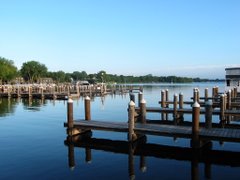Eurasian watermilfoil has been in Minnesota and in Lake Minnetonka for 20 years. We have been lulled into thinking that there is no solution and that this is as good as it gets. We were fortunate last year that it was a low milfoil year, but in most years milfoil has been worse.
We have, individually and collectively, managed milfoil through a) harvesting, b) individual control in front of lakeshore properties or c) tolerance – or at least a benign resignation. Some have suggested that milfoil has been good for fishing. But really, there is nothing good about milfoil. In addition to being a nuisance for recreation and a safety hazard, milfoil causes ecological damage by displacing native plants and diminishing fish habitat.
The Lake Minnetonka Association has been a leader in advocating a more comprehensive approach to controlling milfoil in Lake Minnetonka. The Lake Minnetonka Association sponsored the Milfoil Forum in August of 2005, which led to the 2006 milfoil demonstration project in three bays. The Lake Minnetonka Association and the LMCD partnered to treat small areas in three bays of the lake to control milfoil and enhance native plants. The demonstration project, supported by lakeshore residents, was a success. There was a 99% reduction in milfoil and the native plants increased in the treatment areas.
Based on these positive results as well as sound science, we recommended late last summer that the demonstration project be expanded to include whole bays, beginning in 2007. Unfortunately, that will not happen this year.
Two main obstacles have been identified – the lack of a comprehensive plan and funding. A comprehensive plan, referred to as a Lake Vegetation Management Plan, would take a broad view of the milfoil problem in Lake Minnetonka. The Plan would involve detailed inventories of where milfoil as well as other vegetation grows, the nature of its impacts to lake ecology and recreation and would involve all stakeholders. The outcome of the Plan would be a prescription for the best way to manage milfoil in Lake Minnetonka. It makes sense to approach managing milfoil in Lake Minnetonka as guided by a vegetation management plan.
I have estimated that developing this plan would cost about $100,000 and take about a year.
The other obstacle, funding, I think is highly surmountable. Because we do not yet have a plan, we do not know how much the comprehensive management would cost. However, I have done some preliminary estimates on scenarios that would involve enclosed bays, such as Gray’s Bay or St. Alban’s Bay. Expanding the demonstration treatments to either of these Bays may cost approximately $20,000 per bay and the treatment is expected to last about three years. I have asked several of our members if they and their lakeshore neighbors would be willing to pay these costs and they would. So, I think private funding is a viable option in Lake Minnetonka.
The cost of the plan however, ought to be paid by a public agency. The LMCD Exotic Species Committee is coordinating several agencies in an attempt to piece together a plan for 2007. At this point, it appears plant inventories in three bays may be conducted this year. Unfortunately, unless the other elements of the plan as also conducted this year, this information will not be used in a comprehensive plan.
The Lake Minnetonka Association recommends a comprehensive lake vegetation management plan be conducted this year to allow for expanded treatment in 2008. But, time is short. Unless decisions are made very soon, another field season will pass and another year delay will occur before we can even consider following up on the successful demonstration project.
** This appeared as a Guest Column in Lakeshore Weekly News (April 2007)
Sunday, June 24, 2007
Subscribe to:
Post Comments (Atom)


1 comment:
Interesting to know.
Post a Comment